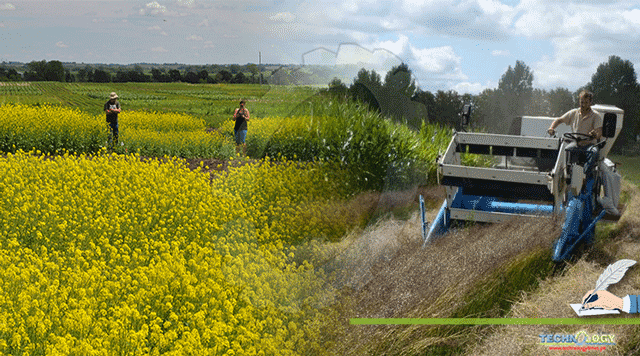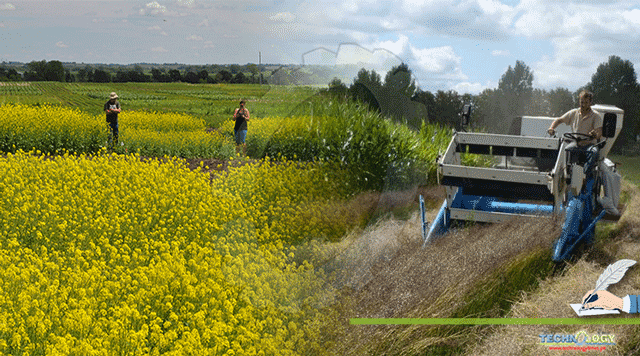Camelina (Camelina Sativa Crop Is Known As False Flax And Belongs To Brassicaceae Family. It Is Oldest Oil Crop In The Temperate Regions.

Agriculture business play a key role to enhance economic status of a Pakistan. It depends on crops yield, product’s quality, inputs, and export enterprise. As we know that, climate change is a current and main issue that has adverse effects on crops production. Farmers can’t produce maximum yield without solving yield reducing problems either related to inputs (water & fertilizer etc.) and soil productivity. Basically, climate variability resulted in temperature fluctuation that directly effects on crop phenology. Crops need more water under higher temperature due to more evapotranspiration. The other inputs like fertilizers especially ammonia volatilization due to maximum temperature also caused environmental pollution.
Researchers are working to addresses these issues and introducing new techniques to reduce environmental pollution, and innovative crops like quinoa, chia, foxtail millet and camelina etc. to enhance farmers profit with low inputs application. New emerging crops have high nutritional profiles, profit and export chances as compared to major crops like maize, wheat, rice, sugarcane and cotton etc. Among new innovative crops, Camelina sativa has a great potential to produce sustainable yield under climate variability conditions.
Introduction
Camelina (Camelina Sativa) Crop Is Known As False Flax And Belongs To Brassicaceae Family. It Is Oldest Oil Crop In The Temperate Regions And Produced In Europe Since 19th Century. It can be grown under difference environmental and edaphic conditions. Camelina is a drought tolerant crop and needs less inputs than other oilseed crops. It has unique characteristics like low temperature adaptability, short growing duration (85 to 105 days) and sustainable input for biofuels production as well. Camelina oil used in paints, coatings of different material, dermatological and cosmetics products. It is more resistant to insect pests and diseases as compared to other Brassicaceae family crops. The camelina seed is used in porridge and bread. It has great potential for minimum cost feed stock for biofuel production industries. The oil is used in salad dressing, baking, cooking, mixed fats, mayonnaise and ice creams. Camelina oil is a great source of omega-3 fatty acid due to its minimum cholesterol properties makes it suitable for human diet. The oil also rich in linoleic acid, alpha-linoleic acid, fatty acids, carbohydrates, proteins, vitamins and minerals. The vitamins included thiamin (B1), niacin (B3) and pantothenic acid (B5). The seeds contained minimum level of macro nutrients, but maximum level of iron, manganese, and zinc. All nutrients, vitamins and minerals contents are affected by environmental and edaphic conditions.
Byproducts of camelina crop
Camelina crop byproducts have wide range of uses due to its unique nutrients composition. Biodiesel is a renewable fuel made from animal fat, vegetable oils and has great attraction in petro-diesel fuel business. The advantages of biofuel included higher cetane number, lower sulfur contents and minimum carbon monoxide emissions. Recent studies showed that methyl ester produced from camelina oil contained maximum iodine content which is useful against lubricating oil deterioration. Camelina biofuel production is a safe option under climate change scenarios due to its low carbon monoxide emissions compared to other oil crops. The other main byproduct of camelina is oil cake used in animal feed production. Camelina cakes contained residual oil, crude protein, amino acids, fibers, minerals, cysteine, glycine, lysine contents. It is also suitable for poultry feed. According to research camelina oil used for chicken feed enhanced omega-3 contents in the eggs. Camelina seeds and oil also proved to reduced cholesterol level in humans. Regular use of camelina seeds and oil reduced LDL (low density lipoprotein) levels effectively in humans. It has antioxidants and tocopherols and helpful in the cells regeneration, slenderness recovery and skin elasticity.
Camelina production requirements
Camelina sativa is a crop of temperate regions and grown in winter and zaid-rabi season (February) in Pakistan. It is self-pollinating crop by means of insects. The seed rate is 6 to 7 kg ha-1. Researchers reported that camelina seeds contained approximately 44% edible oil with quality nutritional contents as compared to other crops. Pre emergence herbicide is recommended at time of soil preparation. The plant growth and development is affected by nutrients application. It required minimum rate of N, P and K based fertilizers. It can be harvested by combine harvester. The water contents of seed less than 11% at time of harvesting. For long time storage purpose seed moisture contents should not exceed 8%. Humidity deteriorate the seed quality and price as well.
Future research
Climate variability is a major issue across the globe. It caused major loss in crop production due to high temperature, erratic rainfall, wind storm etc. So, farmers must know about new crops which can easily adjustable in current cropping scheme and required minimum inputs for higher yield production. The price of camelina crop is higher in market than other crops. So, farmers can get higher profit rate and improve their life style.
